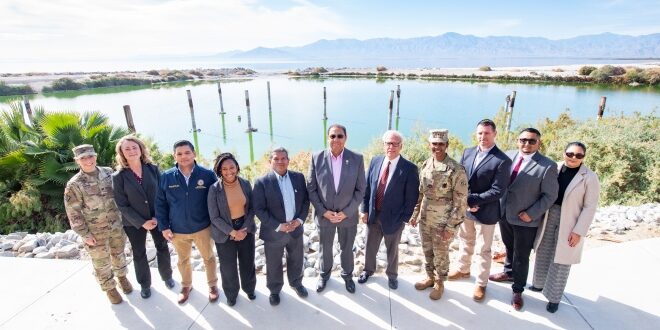The Salton Sea Management Program, U.S. Army Corps of Engineers – Los Angeles District, and the Salton Sea Authority have signed an agreement to identify projects and actions for the long-term restoration of the Salton Sea.
The Corps has received funding to initiate and complete the Imperial Streams Salton Sea and Tributaries Feasibility Study, which will investigate and recommend projects and/or actions to contribute to improved public health and potential environmental restoration opportunities for communities around the Salton Sea.
The study will build on the Salton Sea Management Program’s Long-Range Plan document, released as a draft for public comment on December 15. The cost-share agreement brings together a diverse set of skills and experience from the three agencies and creates a framework for working collaboratively. Additionally, the agreement could potentially lead to significant additional investments for the long-term restoration of the Salton Sea.
The Draft Salton Sea Long-Range Plan was developed with support from Tribal leadership, community-based organizations, and local, state, and federal agencies. The draft long-range plan organizes public input into a framework that provides a foundation for the feasibility study and associated environmental review process.
“This study will help chart a path forward toward the long-term restoration of the Salton Sea,” said Wade Crowfoot, California Natural Resources Secretary. “It will identify projects to improve conditions at the Sea and opens the possibility of new federal funding to deliver these projects. We’re grateful to the Army Corps of Engineers and the Salton Sea Authority for their partnership and look forward to more community engagement to help inform this effort.”
The Salton Sea, California’s largest lake, is facing multiple challenges. With decreased inflow, the lake is shrinking and rising in salinity. As a result, thousands of acres of lakebed are being exposed and habitat has become greatly diminished. In recent years, water transfers have been the primary cause for reduced inflow. With historic drought in the seven states that are part of the Colorado River Basin and increasing demand on the Colorado River, which also feeds the Salton Sea, an acceleration of adverse conditions is expected in the future. Local, state, federal and Tribal agencies are committed to addressing the challenges in the near- and long-term future, in ways that benefit the environment, wildlife and local communities.
A resolution of the U.S. Senate Committee on Environment and Public Works, 114th Congress, authorized the Secretary of the Army to investigate and recommend improvements for flood-risk management, ecosystem restoration and other water- and land-related resources, with a view toward restoration and protection of the environment, and improvements to public health and safety for the Salton Sea and its tributaries in Riverside, Imperial, and San Diego counties
 California Water News Daily Your Source For Water News in California
California Water News Daily Your Source For Water News in California


